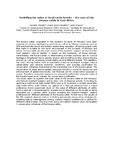| dc.description.abstract | The Borana cattle, originated in the southern lowlands of Ethiopia, have been exported to various neighbouring countries as well as to Western countries such as USA and Australia due to the breed’s outstanding reputation of having unique traits that make it suitable for the harsh environment in the lowlands. In Ethiopia and Kenya, Borana cattle are the main source of the livestock-keepers’ income and the local people’s cultural identity is based on the husbandry of these animals. Nevertheless, the Borana breed is deteriorating in these countries and its cultural heritage is threatened due to genetic erosion and dwindling number of pure Borana animals as well as increasing crossbreeding among different breeds. This depletion has many driving factors such as population pressure, ecological changes, natural catastrophes and adverse economic conditions, and provides justification for conservation initiatives that preserve the irreversible loss of the Borana genes. The conservation of these animal genetic resources (AnGR) is crucial for future use and enhancement of global biodiversity, but financial aid for conservation purposes is scarce. Therefore, economic measures are needed to confirm the economic value of the Borana breed as an indicator for conservation justification.
This study seeks to quantify the total value of the Borana cattle to the Ethiopian and Kenyan livestock-keepers and to show why it deserves priority in funding by applying a multinomial logit model (MNL) and as its extension a random parameter logit model (RPL). Both models are applied to a data set obtained from a stated preference choice experiment study on the value of different attributes of cattle. Such a data set is characterised by discrete choice data that can be sought as being generated via a random utility process revealing the livestock-keepers’ relative preferences for different attributes of the Borana cattle. Furthermore, the results of the RPL supports decision-makers in finding appropriate conservation strategies by shedding light on heterogeneity among livestock-keepers’ preferences or utilities for different cattle breeds, showing which group of livestock-keepers could be targeted in conservation initiatives of the Borana cattle. | en |

